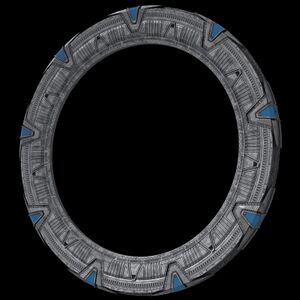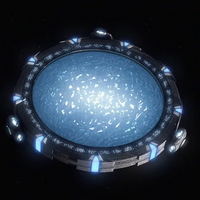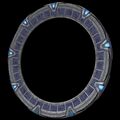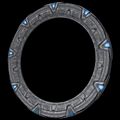

The Hermod Gate is a version of the Stargate designed and built by a consortium of governments, including the United Federation of Planet, Serenity Concord, Klingon Empire, Romulan Star Empire, Cardassian Union, and Ferengi Alliance. Stargate Construction Project of Solas Tempus was heavily dependent on sourcing a rare element that does not exist in this reality, called Naquadah. This material acts as an incredibly strong building material but also an unusually powerful capacitor to build a charge for the artificial wormhole. The Hermod Consortium, established by the Janus-Hermod Treaty named after the Norse messenger God of Frigg, builds and maintains the gate network for the benefit of all. Members of the consortium have control over gates within their territories but treaties signed provide that no member will prevent operation of the gate network between political powers. This is similar to the treaties about warp drive, Hyperspace travel, and other universally accepted methods travel through space.
- Dimensions
- 6.7 Meter Diameter from Edge to Edge
4.9 Meter Diameter Opening - Power Source
- Fusion Reactors (2 or 4) or Matter/Antimatter Reactor (Powering the Wormhole)
Spacial Variance Reactor (Powering Control System) - Control System
- Onboard Encapsulated Computer Core
External Computer Core Supported - Transceiver
- Subspace-Tachyon Hybrid System
- Construction
- Tritanium-Neutronium Alloy
Hermod Gate Network
The original Stargates used a subspace communications network where each gate also acted as a passive relay allowing the gate network to expand without the need for servers. The Dial Home Device (DHD) also controlled the gates and used this transmission network to broadcast out positioning updates between gates. While the Hermod Gate Network does accept these subspace signals, it uses a hybrid tachyon-subspace transmission system. This hybrid system is similar to the system used in Hyperspace to allow navigation between Jump Gates. The subspace-tachyon hybrid system allows for the gate network to not only use gates themselves as relays but also transmission through Jump Gates, subspace relays, and other communication networks. The system is capable of dynamic mode switching to subspace relay networks used by any known race.
Each government can choose their own symbology and the dynamic symbol system updates to connect to gates which use a different symbology. Usually the gates symbols are determine by the official language of the government in question. The gate network is capable of accommodating any symbol.
Operation


The gate follows the design principles of the Type 2 and 3 gates, though some of the design points of the Type 1 gate were also used. Designed to primarily work with a computer interface, the symbols on the gate are dynamic. The gate has been designed to work in three primary operation modes.
Direct Dial
Using a unique 9-symbol address the gate is capable of locking onto a remote gate by its unique hardware address. The dynamic symbol system allows for an unlimited number of gates based on using any possible symbols. Each gate is given a 9-symbol address, which is unique. This is a holdover from the original Stargate system and is kept for compatibility.
In this mode the gate itself calculates, using nearby gates as reference points. In this mode the target gate does not have to calculate its own position and allows gates to be contacted across any distance.
Relative Dial
The original gate system used a 6-symbol relational address with a 7th point of origin. Since objects in space move at high speed relative to each other, there are 6 cardinal gate locations, whose point of origin symbols are used to tell the system points which a gate keeps a lock on its relative position to each. Using these 6 gate locations the system can pinpoint a gate anywhere in 3 dimensional space relative to a point of origin using 6 uniquely triangulated coordinates. This is then used to compute the Janus Coordinates of each gate dynamically.
In this mode, the target gate calculates its exact position relative the cardinal locations and the origin gate does the same. Using this information the gates are able to check each other.
Cardinal Gates
Cardinal gates are designed to sit at roughly 90-degree angles in 3 dimensional space from each other. The calculations required to provide a stable relative lock provide the best positioning when a set of 3 pairs of gates sit with each pair opposite each perpendicular to the other pairs. Since all objects in space are in motion relative to each other, there is significant leeway but paired cardinal gates should be on opposite sides of the target gain. Any gate can be a cardinal gate location for as many gates as are necessary. To make addressing simpler, these cardinal locations are chosen by the consortium to be locations which are nor only relatively stable in terms of their physical environment but also in terms of political stability of the site.
Multiple Networks
This mode also allows gates to be accessed across networks. While the Hermod Gate Network is a single network, whose reference point is the Milky Way galaxy. An 8th symbol can be used to target a remote gate network, the address system was designed to be local to a single galaxy. An exponentially higher amount of power is required to create a wormhole across the intergalactic void. This use of an 8th symbol also allows for isolated Stargate networks. In the provisions of the treaties which govern the Hermod Consortium, any member government can create an isolated network for the purposes of national security. Such gate would require the use of an 8th symbol, which could be any symbol created.
Direct Control
A computer system connected to the gate can directly take over its functions and slave the gate, overriding the internal calculations and directly form a wormhole. In direct control mode the gate accepts Janus Coordinates and thus any gate with sufficient power can be used as a Janus Gate.
Gate-to-Gate Wormhole
When operating normally the system will establish a wormhole from one gate to another directly. In these cases the gate contains the wormhole's event horizon. Crossing the event horizon causes matter to be dematerialized and the matter stream is transmitted through the wormhole and rematerialized on the other side by the destination gate. This is one of the reasons that the original Stargates were one-way except for electromagnetic radiation. The wormhole is designed to transmit a matter stream from one gate to another, similar to how the transporter works.
Wormhole Without a Gate
The new gate design allows for a wormhole to open up without a gate on both sides. While it is safest to operate direct gate-to-gate connections, the gate can project a wormhole. When this occurs the origin gate uses a method similar to a transporter to broadcast a matter stream through the wormhole to materialize on the other side.
Power Source & Naquadah
Since the rare heavy element Naquadah is not known to exist in this reality, the gate uses an internal superconductive subspace amplifier. Instead of drawing and storing large amounts of power in order to generate a wormhole, the device uses an amplifier which works on a similar concept to the Spacial Variance Reactor. Though instead of relying on a flow of verteron particles across the subspace field barrier, it forces high energy plasma through an artificial vacuum energy matrix. The result is a momentary amplification of 4 orders of magnitude to establish the wormhole. Once the subspace connection is formed, the gate draws power at a far lower level to maintain the wormhole.
Security
Each Hermod Gate is equipped with a software package that allows the gate to relay unwanted wormhole activity to another approved gate. In this way governments can control who can enter their territory and prevent the gates from being weaponized against them. Similarly the gates are also equipped with a force field generator which can effectively close a gate to incoming traffic. While the original documentation with the Stargates described methods for using force fields and a physical iris to prevent gate travel to a secure location, both of these methods would lead to the death of someone attempting to travel to such a secured location. The Hermod Gate force field closes the gate by preventing an incoming wormhole from establishing a connection while the relaying program receives a matter stream from the incoming wormhole and forwards it through the network to a preselected auxiliary gate.
The use of force fields or other technologies which result in the death of an incoming traveller are prohibited by the treaty on any open gate network.
The gate will not allow a connection to be established if there is a biological entity within space where the wormhole will form. Gates terminate if nothing is transmitted through the wormhole within a period of several seconds, though it is configurable it is usually between 3-7 seconds.
Private Gate Networks
Governments are entitled to use build and use private gate networks but it is a violation of the treaty to operate a parallel gate network, that is to say a network of gates which mirrors the Hermod Gate Network within their space in order to subvert the Janus-Hermod Treaty.
Failsafe
The gate software prevents establishing a connection which would cause the wormhole to go through stellar phenomena which could either cause a negative impact to the traveller or objects in space. Since the wormhole travels through subspace most objects in space, or even a starship traveling at warp, would not be impacted by a wormhole passing through them through subspace. Stellar phenomena which create their own significant gravitational / magnetic fields which cross subspace layers can be effected, this includes stars, black holes, and spacial anomalies. As such the gate software will fail to connect if the path of the wormhole intersects with these objects.
The gate software is capable of relaying wormhole through a secondary tertiary gate connection, provided one can be found, in order to establish a connection but avoid such phenomena.
Non-Stationary Gates
A gate is always placed on a moving object. Planets move around their sun and solar systems move around the galactic core. Thus a gate can be placed on any object, even a space craft. In order to establish a wormhole a gate must be on a vessel traveling in normal space and at sub-light speeds. For a space craft to have a gate with an active wormhole it must be as close to stationary as possible. The subspace-inertial forces could cause significant damage to a vessel attempting to travel at even moderate speed while a wormhole is established. While a planet's gravitational field isolates it from these forces, a space craft cannot generate such a field.
Exterior
-
Front On
-
Back On
-
Top Off
-
Top On



